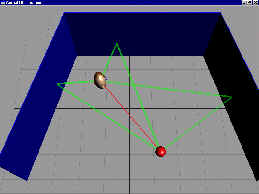Introducing Aurealís A3D Version 2.0 and
the Vortex 2 chipset
| The new A3D version 2.0 is a great
improvement over its predecessor. A3D 1.0 was the first 3D audio
API developed by Aureal for the PC. This version was adopted by many games
and soon caught the attention of sound card manufacturers. Coupled with
the Vortex 1 chipset, sound cards were able to produce 3D audio with a
standard two speaker or four-speaker configuration. |
 |
The final result wasnít exactly an earth-shattering
experience, but it was miles better than the conventional DirectSound3D
positional audio. But all of this came at a price, because typical A3D
1.0 acceleration would require something between 20%-30% of CPU utilization,
decreasing the frame rate during gameplay.
Aureal has now changed all this with the second
version of A3D. We received the overview of this version from Aurealís
website.
A3D 2.0 Overview
Building on the breakthrough success of A3D,
Aureal is introducing A3D 2.0 as the next generation of its positional
3D audio standard. Designed to take full advantage of Aurealís Vortex 2
chip, A3D 2.0 is fully backward-compatible with A3D while introducing the
following:
+ Vortex 2 support: more 3D sources, higher
sample rate, bigger HRTF filters
+ Aureal Wavetracing: real-time acoustic reflection,
reverb and occlusion rendering
+ A2D: host CPU based A3D emulation mode for
non-accelerated PCs
+ A3D API: all-in-one interface to support
A2D, A3D, A3D 2.0 and DirectSound3D
+ Advanced resource management features
+ A3D authentication protection
As you can see, A3D 2.0 is completely backward-compatible
with the first version, and also supports A2D and DirectSound3D. A2D is
an software fallback engine for A3D, used to emulate A3D on systems that
donít include support for 3D hardware decoding. A2D can also be used to
"backfill" software rendering buffers if an application runs out of A3D
hardware resources.
The most distinguished feature of A3D 2.0 is the
inclusion of wavetracing to simulate realistic environments. By using the
wavetracing engine, the sound card is able to produce much more sophisticated
audio effects: for instance, to place you in a room and then simulate how
sounds would behave when bouncing off of walls or other objects. If you
are walking on a metal floor, your footsteps will echo throughout the hallway
as they are created by the impact of your feet with the floor and then
the sound bounced off the walls. A3D 2.0 also supports a feature called
occlusion, the ability to give a sound a blocked property. This will allow
sound to be blocked as it travels from room to room or it is blocked out
by an object that disturbs the source. For example if someone or
something is standing in front of or behind you, the background effects
will tend to fade in volume. Or, a wall or an object could silence gunshots
in the next room. Occlusion is demonstrated in the picture to the left,
where sound cannot travel directly between the two objects because of the
intervening wall. Here, sound is being bounced off the walls (as shown
by the green lines) instead of travelling directly (along the path shown
by the red line) as in the picture to the right.

|

|
By using the Aureal Vortex 2 PCI audio accelerator
utilizing A3D 2.0, the Monster Sound MX300 is able to calculate the way
objects and surfaces in a virtual 3D environment reflect sound, and automatically
adjusts the properties of the environment, providing up to 16 3D sounds
simultaneously. As a result, sound effects differ from tunnels, caves,
walls, open rooms, outdoor environments and battlefields since the reflections
and the occlusions depends on the acoustic characteristics of the environment.
These simulated 3D audio environments can be experienced from your home
PC, through 2 or 4 speakers and headphones.
The Aureal Vortex 2 PCI audio accelerator completes
all these tasks without being a heavy burden on the host CPU. This chip
itself includes 3.3 million transistors and boasts a maximum audio processing
power of 600MIPS. Unlike the previous Vortex 1 chipset, the Vortex 2 features
the necessary processing power to take advantage of the newly implemented
audio APIs and produce surround sound without eating up valuable CPU cycles.
This, in return, provides faster frame rates and places you in the most
thrilling and all-encompassing gaming environment possible. |


